Dodge Challenger
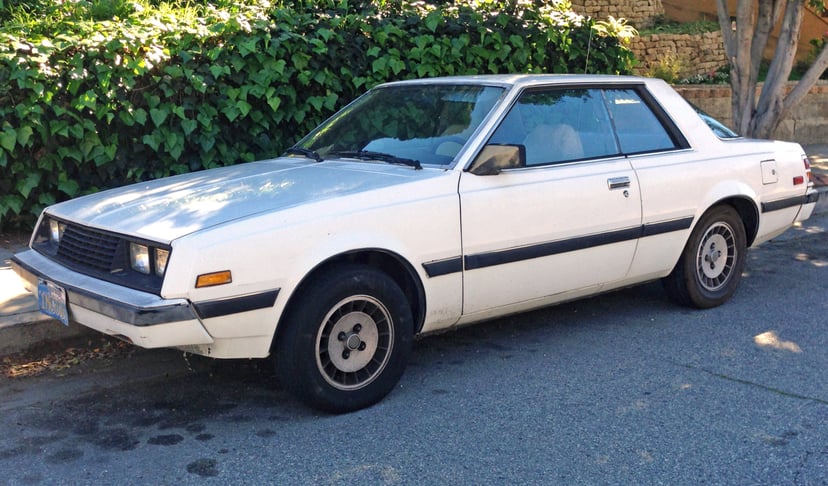
Dodge Challenger

| Dodge Challenger | |
|---|---|
 | |
| Overview | |
| Manufacturer |
|
| Production |
|
| Model years |
|
| First generation | |
 1970 Dodge Challenger T/A | |
| Overview | |
| Production | September 1969–1974 |
| Model years | 1970–1974 |
| Assembly |
|
| Designer | Carl Cameron (1968) |
| Body and chassis | |
| Class | Pony car, Muscle car, Compact car (S) |
| Body style | Convertible, Hardtop/Notchback Coupé |
| Layout | Front engine, rear-wheel-drive |
| Platform | E-body |
| Doors | 2 |
| Related | Plymouth Barracuda |
| Powertrain | |
| Engine | |
| Transmission |
|
| Dimensions | |
| Wheelbase | 110 in (2,800 mm) |
| Length | 191.3 in (4,860 mm)[2] |
| Width | 76.1 in (1,930 mm) |
| Height | 50.9 in (1,290 mm) |
| Second generation | |
| Overview | |
| Production | 1977–1983 |
| Model years | 1978–1983 |
| Assembly | Japan: Okazaki, Aichi |
| Body and chassis | |
| Class | Subcompact car |
| Body style | 2-door hardtop/notchback coupe |
| Layout | Front engine, rear-wheel-drive |
| Related | Mitsubishi Galant Lambda Plymouth Sapporo |
| Powertrain | |
| Engine | 1.6 L (98 cu in) 4G32 I4 2.6 L (160 cu in) 4G54 I4 |
| Transmission | 5-speed manual 3-speed automatic |
| Dimensions | |
| Wheelbase | 2,530 mm (100 in) |
| Length | 4,525 mm (178.1 in) |
| Width | 1,675 mm (65.9 in) |
| Height | 1,345–1,355 mm (53.0–53.3 in) |
| Third generation | |
 2015 Challenger SRT 392 in Jazz Blue Pearl | |
| Overview | |
| Production | April 2008–present |
| Model years | 2008–present |
| Assembly | |
| Designer | Michael Castiglione, Alan Barrington (2004-2005)[23] Jeff Gale, Brian Nielander (2006) |
| Body and chassis | |
| Class | Muscle car, Mid-size car |
| Body style | 2-door notchback coupe |
| Layout | Front-engine, rear-wheel-drive Front engine, all-wheel-drive |
| Platform | Chrysler LC platform (2008-2014) Chrysler LA platform (2015-present) |
| Related | Chrysler 300 Dodge Charger Dodge Magnum Mercedes-Benz E-Class (2008-2010) Mercedes-Benz S-Class (2008-2010) |
| Powertrain | |
| Engine | 3.5 L (215 cu in) SOHC V6 (2009–2010) 3.6 L (220 cu in) Pentastar DOHC V6 (2011–present) 5.7 L (345 cu in) HEMI OHV V8 (2009–present) 6.1 L (370 cu in) HEMI OHV V8 (2008–2010) 6.2 L (376 cu in) Hellcat OHV V8 S/C (2015-present) 6.2 L (376 cu in) Demon Hemi OHV V8 S/C (2018–present) 6.4 L (392 cu in) HEMI OHV V8 (2011–present) |
| Transmission | 4-speed automatic 42RLE (2009) 5-speed automatic W5A580 (2008–2014) 8-speed automatic 845RE, 8HP70, 8HP90 (2014-present) 6-speed manual Tremec TR6060 (2008-present) |
| Dimensions | |
| Wheelbase | 116.0 in (2,946 mm) |
| Length | 197.7 in (5,022 mm) |
| Width | 75.7 in (1,923 mm) |
| Height | 55.7–57.5 in (1,415–1,460 mm) |
| Curb weight | 3,834 lb (1,739 kg) (SXT)[24] 4,100 lb (1,860 kg) (R/T)[25] 4,226 lb (1,917 kg) (Scat Pack)[26] 4,469 lb (2,027 kg) (SRT Hellcat)[27] 4,254 lb (1,930 kg) (SRT Demon) |
The Dodge Challenger is the name of three different generations of automobiles (two of those being pony cars) produced by American automobile manufacturer Dodge. However, the first use of the Challenger name by Dodge was in 1959 for marketing a "value version" of the full-sized Coronet Silver Challenger.
From model years 1970 to 1974, the first generation Dodge Challenger pony car was built using the Chrysler E platform in hardtop and convertible body styles sharing major components with the Plymouth Barracuda.[1]
The second generation, from model years 1978 to 1983, was a badge engineered Mitsubishi Galant Lambda, a coupe version of an economical compact car.
The third and current generation is a pony car that was introduced in early 2008 originally as a rival to the evolved fifth generation Ford Mustang and the fifth generation Chevrolet Camaro.
| Dodge Challenger | |
|---|---|
 | |
| Overview | |
| Manufacturer |
|
| Production |
|
| Model years |
|
| First generation | |
 1970 Dodge Challenger T/A | |
| Overview | |
| Production | September 1969–1974 |
| Model years | 1970–1974 |
| Assembly |
|
| Designer | Carl Cameron (1968) |
| Body and chassis | |
| Class | Pony car, Muscle car, Compact car (S) |
| Body style | Convertible, Hardtop/Notchback Coupé |
| Layout | Front engine, rear-wheel-drive |
| Platform | E-body |
| Doors | 2 |
| Related | Plymouth Barracuda |
| Powertrain | |
| Engine | |
| Transmission |
|
| Dimensions | |
| Wheelbase | 110 in (2,800 mm) |
| Length | 191.3 in (4,860 mm)[2] |
| Width | 76.1 in (1,930 mm) |
| Height | 50.9 in (1,290 mm) |
| Second generation | |
| Overview | |
| Production | 1977–1983 |
| Model years | 1978–1983 |
| Assembly | Japan: Okazaki, Aichi |
| Body and chassis | |
| Class | Subcompact car |
| Body style | 2-door hardtop/notchback coupe |
| Layout | Front engine, rear-wheel-drive |
| Related | Mitsubishi Galant Lambda Plymouth Sapporo |
| Powertrain | |
| Engine | 1.6 L (98 cu in) 4G32 I4 2.6 L (160 cu in) 4G54 I4 |
| Transmission | 5-speed manual 3-speed automatic |
| Dimensions | |
| Wheelbase | 2,530 mm (100 in) |
| Length | 4,525 mm (178.1 in) |
| Width | 1,675 mm (65.9 in) |
| Height | 1,345–1,355 mm (53.0–53.3 in) |
| Third generation | |
 2015 Challenger SRT 392 in Jazz Blue Pearl | |
| Overview | |
| Production | April 2008–present |
| Model years | 2008–present |
| Assembly | |
| Designer | Michael Castiglione, Alan Barrington (2004-2005)[23] Jeff Gale, Brian Nielander (2006) |
| Body and chassis | |
| Class | Muscle car, Mid-size car |
| Body style | 2-door notchback coupe |
| Layout | Front-engine, rear-wheel-drive Front engine, all-wheel-drive |
| Platform | Chrysler LC platform (2008-2014) Chrysler LA platform (2015-present) |
| Related | Chrysler 300 Dodge Charger Dodge Magnum Mercedes-Benz E-Class (2008-2010) Mercedes-Benz S-Class (2008-2010) |
| Powertrain | |
| Engine | 3.5 L (215 cu in) SOHC V6 (2009–2010) 3.6 L (220 cu in) Pentastar DOHC V6 (2011–present) 5.7 L (345 cu in) HEMI OHV V8 (2009–present) 6.1 L (370 cu in) HEMI OHV V8 (2008–2010) 6.2 L (376 cu in) Hellcat OHV V8 S/C (2015-present) 6.2 L (376 cu in) Demon Hemi OHV V8 S/C (2018–present) 6.4 L (392 cu in) HEMI OHV V8 (2011–present) |
| Transmission | 4-speed automatic 42RLE (2009) 5-speed automatic W5A580 (2008–2014) 8-speed automatic 845RE, 8HP70, 8HP90 (2014-present) 6-speed manual Tremec TR6060 (2008-present) |
| Dimensions | |
| Wheelbase | 116.0 in (2,946 mm) |
| Length | 197.7 in (5,022 mm) |
| Width | 75.7 in (1,923 mm) |
| Height | 55.7–57.5 in (1,415–1,460 mm) |
| Curb weight | 3,834 lb (1,739 kg) (SXT)[24] 4,100 lb (1,860 kg) (R/T)[25] 4,226 lb (1,917 kg) (Scat Pack)[26] 4,469 lb (2,027 kg) (SRT Hellcat)[27] 4,254 lb (1,930 kg) (SRT Demon) |
First generation (1970–1974)
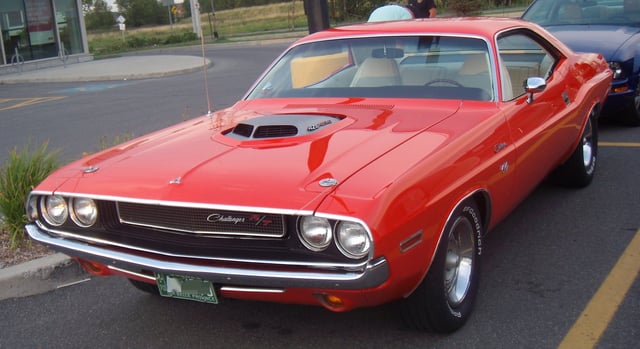
1970 Dodge Challenger R/T coupe with a 426-cubic inch engine
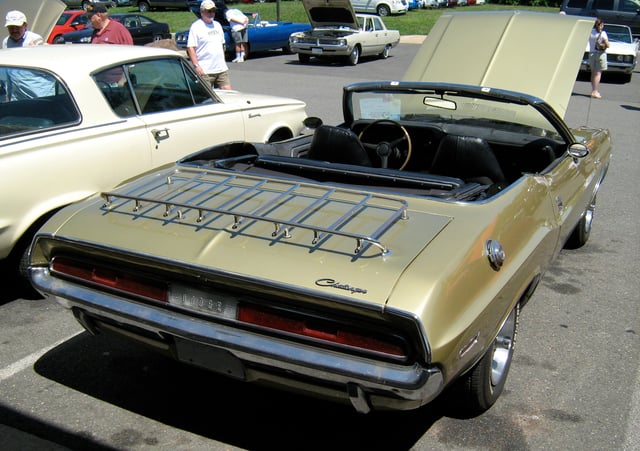
1970 convertible with I6 showing the center mounted backup light

1971 Dodge Challenger R/T with the 440-cubic inch engine (note the dual snorkels in the grille)
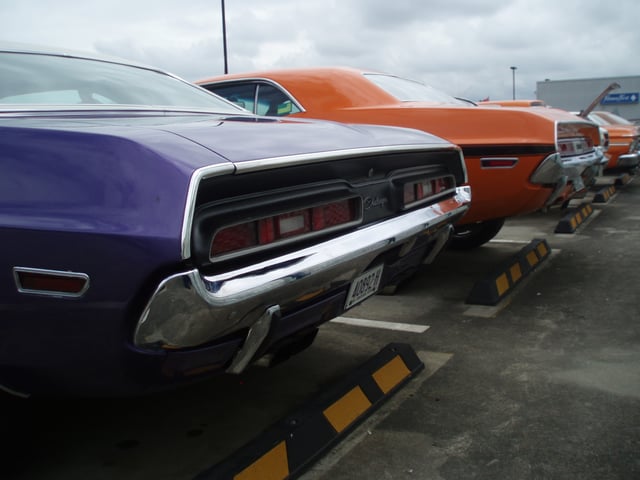
1971 Dodge Challenger R/T taillights next to the 1970 version
Introduced in fall 1969 for the 1970 model year,[3] the Challenger was one of two Chrysler E-body cars, the other being the slightly smaller Plymouth Barracuda. Positioned to compete against the Mercury Cougar and Pontiac Firebird in the upper end of the pony car market segment,[4] it was "a rather late response" to the Ford Mustang, which debuted in April 1964.[5] Even so, Chrysler intended the new Challenger as the most potent pony car ever,[6] and, like the less expensive Barracuda, it was available in a staggering number of trim and option levels, and with virtually every engine in Chrysler's inventory.[7]
The Challenger's longer wheelbase, larger dimensions, and more luxurious interior were prompted by the launch of the 1967 Mercury Cougar, likewise a bigger, more luxurious and more expensive pony car aimed at affluent young American buyers.[8] The 110 in (2,800 mm) wheelbase was 2 in (51 mm) longer than the Barracuda's, and the Dodge differed substantially in its sheetmetal, much as the Cougar differed from the shorter-wheelbase Mustang. Air conditioning and a rear window defogger were optional.[9] With 1971 being the sole exception, the front ends of both cars differed from each other in that the Challenger had four headlights and the Barracuda had only two; this is similar to how the 1967–73 Mustangs and Cougars looked, as well as the 1967–69 Camaros and Firebirds.
Exterior design was penned by Carl Cameron, who was also responsible for the exterior designs of the 1966 Dodge Charger. Cameron based the 1970 Challenger grille on an older sketch of an unbuilt 1966 Charger prototype that was to have a turbine engine. Although the Challenger was well received by the public (with 76,935 produced for the 1970 model year), it was criticized by the press, and the pony car segment was already declining by the time the Challenger arrived. Sales fell dramatically after 1970, and though sales rose for the 1973 model year with over 27,800 cars being sold, Challenger production ceased midway through the 1974 model year. A total of 165,437 Challengers were sold over this generation's lifespan.
Models

SE "formal" rear window
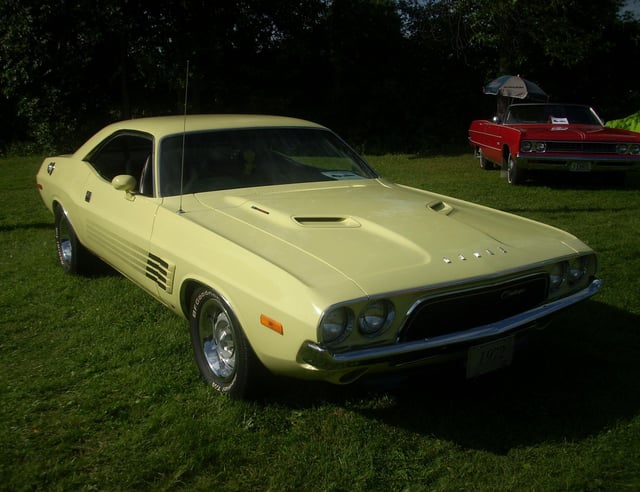
1972 Dodge Challenger Rallye
The Challenger was available as either a two-door hardtop coupe or a convertible, and in two models for its introductory model year.[10] The base model was the "Challenger" with either an Inline-6 or V8 engine, as well as a "Challenger R/T" that included a 383 cu in (6.28 L) V8. The Special Edition (SE) trim package added a number of appearance, convenience, and comfort items, on either the base Challenger or the R/T.[11] The standard engine on the base model was a 225 cu in (3.7 L) Straight-6. The standard engine on the higher trim models was a 318 cu in (5.2 L) V8 with a 2-barrel carburetor. For 1970, the optional engines included the 340 and 383 cu in (5.6 and 6.3 L), as well as the 440 and 426 cu in (7.2 and 7.0 L) V8s, all with a standard 3-speed manual transmission, except for the 290 bhp (216.3 kW) 383 cuin. engine, which was available only with the TorqueFlite automatic transmission. A 4-speed manual was optional on all engines except the 225 CID Inline-6 and the 2-barrel 383 CID V8.
For 1971, the Challenger line up was modified to include a new model, the "Challenger Coupe" with either an Inline-6 or V8 engine, and as the most basic option, it had a fixed quarter windows and a basic black steering wheel with horn button.[12]
The performance model was the R/T (Road/Track), with a 383 cu in (6.3 L) "Magnum" V8, rated at 335 bhp (250 kW); 300 bhp (224 kW) for 1971, due to a drop in compression. The standard transmission was a 3-speed manual. Optional R/T engines were the 375 bhp (280 kW) 440 cu in (7.2 L) Magnum, the 390 bhp (291 kW) 440 cu in (7.2 L) Six-Pack and the 426 cu in (7.0 L) Hemi rated at 425 bhp (431 PS; 317 kW) at 5,000 rpm and 490 lb⋅ft (664 N⋅m) at 4,000 rpm of torque.[13] The R/T was available in either the hardtop or convertible. For 1970 only, base hardtop and R/T hardtop models could be ordered with the more luxurious SE specification, which included leather seats, a vinyl roof, a smaller 'formal' rear window, and an overhead interior console that contained three warning lights (door ajar, low fuel, and seatbelts).[14] The Challenger R/T came with a Rallye instrument cluster that included a 150 mph (240 km/h) speedometer, an 8,000 rpm tachometer,[15] 1972–1974 tachometer went to 7,000 rpm and an oil pressure gauge. In 1972, the R/T badging was dropped and these models were called "Rallye", although they were never badged as such. The Rallye model featured a faux brake vent on the fenders. The shaker hood scoop was not available after 1971.
A special model only available for the 1970 model year was the Dodge Challenger T/A (Trans Am) racing homologation car. In order to race in the Sports Car Club of America's Trans American Sedan Championship Trans Am, Dodge built a street version of its race car (just like Plymouth with its Plymouth 'Cuda AAR) which it called the Dodge Challenger T/A (Trans Am). Although the race cars ran a destroked version of the 340, street versions took the 340 and added a trio of two-barrel carburetors atop an aluminum intake manifold, creating the 340 Six Pack. Dodge rated the 340 Six Pack at 290 bhp (216 kW), only 15 bhp (11 kW) more than the original 340 engine (which also had the same rating as the Camaro Z/28 and Ford Boss 302 Mustang). The engine actually made about 320 bhp (239 kW). It breathed air through a suitcase-sized air scoop molded into the pinned down, hinged matte-black fiberglass hood. Low-restriction dual exhaust ran to the stock muffler location, then reversed direction to exit in chrome tipped "megaphone" outlets in front of the rear wheels. Options included a TorqueFlite automatic or pistol-grip Hurst-shifted four-speed transmission, 3.55:1 or 3.90:1 gears, as well as manual or power steering. Front disc brakes were standard. The special Rallye suspension used heavy duty parts and increased the rate of the rear springs. The T/A was one of the first U.S. muscle car to fit different size tires front and rear: E60x15 Goodyear Polyglas in the front, and G60x15 on the rear axle.[16][17] The modified chamber elevated the tail enough to clear the rear tires and its side exhaust outlets. Thick dual side stripes, bold ID graphics, a fiberglass ducktail rear spoiler, and a fiberglass front spoiler were also included. The interior was identical to other Challengers.
Dodge contracted Ray Caldwell's Autodynamics in Marblehead, Massachusetts to run the factory Trans-Am team. Sam Posey drove the No.77 "sub-lime" painted car that Caldwell's team built from a car taken off a local dealer's showroom floor. When the No.76 was completed mid-season from a chassis provided by Dan Gurney's All American Racers, Posey alternated between the two. Both cars ran the final two races, with Posey in the #77. Ronnie Bucknum drove the No.76 at Seattle Washington, and Tony Adamowicz drove it at Riverside, California.
The Challenger T/A's scored a few top three finishes, but lack of a development budget and the short-lived Keith Black 303 cu in (5.0 L) engines led to Dodge leaving the series at season's end. The street version suffered from severe understeer in fast corners, largely due to the smaller front tires. Only 2,399 T/As were made. A 1971 model using the 340 engine with a 4-barrel carburetor was planned and appeared in advertising, but was not produced since Dodge had withdrawn from the race series.
The "Western Sport Special" was a version available only to west coast dealers. It came with a rear-exit exhaust system and Western Sport Special identification on the rear decklid. Some examples came with a vacuum-operated trunk release. Another late production version was the low-priced "Deputy", stripped of some of the base car's trim and with fixed rear side glass.
For 1972 the options lists (both for performance and appearance/convenience items) had been drastically cut back. The convertible version (though a sun-roof was made available), most interior upgrade options (in particular leather seats), comfort/convenience items (in particular power windows and power seats), and all the big-block engine options were gone. The R/T series was replaced by the Rallye series. Engine choices were down to three: the 225 cu in (3.7 L) slant-6, 318 cu in (5.2 L) V8, and a 340 cu in (5.6 L) V8 that was equipped with a 4-barrel carburetor, dual exhausts, as well as a performance-oriented camshaft and heads. All three engines were detuned to lower compression ratios to use lead-free gasoline, and the horsepower ratings were lowered to reflect the more accurate Society of Automotive Engineers (SAE) net horsepower calculations. Each engine could be mated to a 3-speed manual or automatic transmission, while the 340 could also be equipped with a 4-speed manual if so ordered. The performance axle ratios were also gone except for a 3.55 sure grip which could only be had with the 340 and the heavy duty suspension.[18] The 1972 models also received a new grille that extended beneath the front bumper, as well as new rear tail-lights. Toward the end of the 1971 model year a few convertibles were made with the 1972 front end (grille, lights, etc.) and rear end (tail lights and their panel). These were specially built for TV and movie studio production use and showed up "Mod Squad", and other shows. The only way to ascertain these 1972 Challenger convertible is to look at its fender tag. On the code line which gives the dealer order number, that number will start with an "R", which designates "Special Meaning" (in this case, a TV 'special promotions' car).
The 1972 grille and tail-light arrangement was carried over for the 1973 (and 1974) models, and the mandatory 5 mph bumpers were added. While the 225 cu in (3.7 L) six-cylinder engine was dropped, (leaving just the two V-8s), all option lists otherwise were carry-overs from 1972. For 1974, the 340 cu in (5.6 L) engine was replaced by a 360 cu in (5.9 L) version offering 245 hp (183 kW; 248 PS), but the pony car market had fallen off and production of Challengers ceased in late April 1974. The A/C was not available with the 3-speed manual.[19]
Cosmetic variations
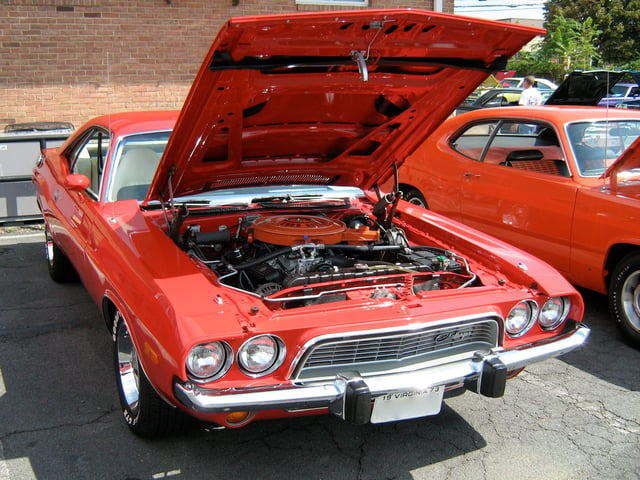
Protruding bumper guards, 1973
Although the body style remained the same throughout the Challenger's five-year run, there were two notable changes to the front grille. The 1971 models had a "split" grille, while 1972 introduced a design that extended the grille (nicknamed the "sad-mouth") beneath the front bumper. With this change to the front end, 1972 through 1974 models had little to no variation. The only way to properly distinguish them is that the 1972s had flush mounted bumpers with no bumper guards, (small bumper guards were optional), while both the 1973 and 1974 models had the protruding "5 mph (8.0 km/h)" bumpers (with a rubber type filler behind them) in conjunction with large bumper guards. The 1974 cars had larger rear bumper guards to meet the (new for 1974 and on) rear 5 mph (8.0 km/h) rear impact law. These changes were made to meet U.S. regulations regarding crash test safety.
The 1970 taillights went all the way across the back of the car, with the backup light in the middle. In 1971, the backup lights were on the left and right instead of the middle. The taillight array also changed for 1972 onwards, with the Challenger now having four individual rectangular lamps.
Collectibility
Although few mourned the end of the E-body models, the passage of time has created legends and highlighted the unique personalities of both the Challenger and the Barracuda.[7] With a low total production, as well as low survivability over the years, any Challenger is worth a substantial amount of money. In a historic review, the editors of Edmunds Inside Line ranked these models as: 1970 was a "great" year, 1971 was a "good" one, and then "three progressively lousier ones" (1972–1974).[7] With total sales and production off by 2/3 from 1970, the performance engine 1971 Challengers are the most rare. Sales and production of the 1973 cars (with only two V8s available) actually exceeded 1971 by approximately 1,700 cars.
Export markets
Dodge Challengers were mainly produced for the U.S. and Canadian markets. Chrysler officially sold Challengers to Switzerland through AMAG Automobil- und Motoren AG in Schinznach-Bad, near Zurich. Only a few cars were shipped overseas each year to AMAG. They did the final assembly of the Challengers and converted them to Swiss specs. There are few AMAG cars still in existence. From a collector's point of view, these cars are very desirable. Today, fewer than five Swiss Challengers are known to exist in North America.[20]
Chrysler exported Dodge Challengers officially to France as well through their Chrysler France Simca operation, since Ford sold the Mustang in France successfully in small numbers. However, only a few Challengers were exported and Chrysler finally gave up the idea of selling them in France.
Engines
The SAE gross horsepower ratings were tested with no accessories, no air cleaner, or open dyno headers. In 1971, compression ratios were reduced in performance engines, except the 426 cu in (7.0 L) and the high performance 440 cu in (7.2 L), to accommodate regular gasoline. The compression ratio would be reduced on the high performance 440 cu in (7.2 L) starting in 1972. 1971 was the last year for the 426 cu in (7.0 L) Hemi.
| Class | Cubic Inches (Litres) | Model | Engine | Carburetor | Exhausts | Power | SAE | Notes |
|---|---|---|---|---|---|---|---|---|
| C | 225 cu in (3.7 L) | Chrysler Slant 6 | I6 | 2-barrel | 1 | 1970-1971 = 145 bhp (108 kW)1971-1972 = 110 bhp (82 kW) | Gross Net | These were the only I6 engines. |
| G | 318 cu in (5.2 L) | Chrysler LA | V8 | 2-barrel | 1 | 1970-1971 = 230 bhp (172 kW)1971-1972 = 155 bhp (116 kW) | ||
| H | 340 cu in (5.6 L) | 4-barrel | 2 | 1970-1971 = 275 bhp (205 kW)1971 = 235 bhp (175 kW) 1972-1973 = 240 bhp (179 kW) | ||||
| J | 360 cu in (5.9 L) | 1974 = 245 bhp (183 kW) | Net | |||||
| 340 cu in (5.6 L) | 3 x 2-barrel | 2 | 1970 = 290 bhp (216 kW)1971 = 275 and 190 bhp (205 and 142 kW) | This engine was used in the T/A. | ||||
| L | 383 cu in (6.3 L) | Chrysler B | 2-barrel | 1 | Gross Net | |||
| 4-barrel | 2 | 1970 = 330 and 240 bhp (246 and 179 kW) | ||||||
| N | 1970 = 335 bhp (250 kW)1971 = 300 and 250 bhp (224 and 186 kW) | Both units were in the Magnum. | ||||||
| U | 440 cu in (7.2 L) | Chrysler RB | 4-barrel Carbureted | 2 | 1970 = 375 bhp (280 kW)1971 = 375 and 305 bhp (280 and 227 kW) | For 1971, the R/T was the only Challenger to use this. | ||
| V | 3 x 2-barrel | 1970 = 390 bhp (291 kW)1971 = 385 and 330 bhp (287 and 246 kW) | This unit was in the Six-Pack. | |||||
| R | 426 cu in (7.0 L) | Chrysler Hemi | 2 x 4-barrel | 1970 = 425 bhp (317 kW)1971 = 350 bhp (261 kW) | 1971 Extra US$1,228, with very few sold. |
Production numbers

RT 440 Six-Pack engine
| Year | Variant | Model | Production | Total |
|---|---|---|---|---|
| 1970 | I6 | Hardtop | 1 | 76,935 |
| Sports Hardtop | 350 | |||
| Convertible | 370 | |||
| V8 | Hardtop | 36,811 | ||
| Hardtop T/A | 2,539 | |||
| Sports Hardtop | 5,873 | |||
| Convertible | 2,543 | |||
| Hardtop R/T | 13,796 | |||
| Special Edition Hardtop R/T | 3,753 | |||
| Convertible R/T | 963 | |||
| 1971 | I6 | Hardtop | 1,672 | 26,299 |
| Convertible | 83 | |||
| V8 | Hardtop | 18,956 | ||
| Convertible | 1,774 | |||
| Hardtop R/T | 3,814 | |||
| 1972 | I6 | Hardtop | 842 | 22,919 |
| V8 | 15,175 | |||
| Hardtop Rallye | 8,123 | |||
| 1973 | Hardtop | 27,930 | 27,930 | |
| 1974 | 11,354 | 11,354 |
Second generation (1978–1983)
- *SeeMitsubishi Galant Lambdafor more information*
The Challenger name was revived in late 1977 for the 1978 model year for a version of the early Mitsubishi Galant Lambda coupe. It was known overseas as the Mitsubishi Sapporo/Scorpion and sold through Dodge dealers as a captive import, originally as the "Dodge Colt Challenger".[21] It was identical except in color and minor trim to the Plymouth Sapporo with the Dodge version emphasizing sportiness, with bright colors and tape stripes, while the Plymouth emphasized luxury, with more subdued trim. The cars were slightly restyled in 1981 with revised headlights and other minor cosmetic changes. Both cars were sold until 1983, when they were replaced by the Conquest, Laser and Daytona.
The car retained the frameless hardtop styling of the old Challenger, but had smaller engines (inline-fours instead of the six and eight-cylinder engines of the old Challenger) and was a long way off in performance from its namesake. Nevertheless, it acquired a reputation as a reasonably brisk performer in its class, not least because of its available 2.6 L "Hemi" engine with 105 hp (78 kW).[21] Four-cylinder engines of this size had not usually been built due to inherent vibration, but Mitsubishi pioneered the use of balance shafts to help dampen this effect, and the Challenger was one of the first vehicles to bring this technology to the American market; it has since been licensed to many other manufacturers.
Third generation (2008–present)
In late 2005, Dodge teased spy photos of the Dodge Challenger prototype on the internet and was announced on November 21, 2005 showing an official drawing sketch of the vehicle.[28] The Dodge Challenger Concept was unveiled at the 2006 North American International Auto Show and was a preview for the 3rd generation Dodge Challenger that started its production in 2008. Many design cues of the Dodge Challenger Concept were adapted from the 1970 Dodge Challenger R/T. It was the second pony car to reuse a previous design in the 2000s, after the 2005 Ford Mustang but before the 2010 Chevrolet Camaro (which was revived after seven years of being out of production).
Initial release
On December 3, 2007, Chrysler started taking deposits for the 3rd-generation Dodge Challenger which debuted on February 6, 2008, simultaneously at the Chicago Auto Show[29] and Philadelphia International Auto Show. Listing at US$40,095, the new version was a 2-door notchback sedan (seated 5 passengers with over 33 cubic feet of rear passenger volume) which shared common design elements with the first generation Challenger, despite being significantly longer and taller. As with Chevrolet's new Camaro, the Challenger concept car's pillarless hardtop body was replaced with a fixed "B" pillar, hidden behind the side glass to give an illusion of the hardtop. The LC chassis is a modified (shortened wheelbase) version of the LX platform that underpins the Dodge Charger (LX), Dodge Magnum, and the Chrysler 300. The LX was developed in America from the previous Chrysler LH platform, which had been designed to allow it to be easily upgraded to rear and all-wheel drive. Many Mercedes components were incorporated, or used for inspiration, including the Mercedes-Benz W220 S-class control arm front suspension, the Mercedes-Benz W211 E-Class 5-link rear suspension, the W5A580 5-speed automatic, the rear differential, and the ESP system. All (7119) 2008 models were SRT8s and equipped with the 6.1 L (370 cu in) Hemi and a 5-speed AutoStick automatic transmission. The entire 2008 Canadian produced run of U.S. run 6,400 cars were pre-sold (many of which for above MSRP), and production commenced on May 8, 2008.
The base model Challenger SE was initially powered by a 3.5 L (214 cu in) SOHC V6 producing 250 bhp (186 kW) (SAE) and 250 lbf⋅ft (339 N⋅m) of torque which was coupled to a 4-speed automatic transmission for the first half of 2009, and was then changed to have a standard 5-speed automatic transmission.[31] Several different exterior colors, with either cloth or leather interiors became available. Standard features included air conditioning, power windows, locks, and mirrors; cruise control, and 17-inch (430 mm) aluminum wheels. Leather upholstery, heated front seats, sunroof, 18-inch aluminum wheels, and a premium audio system are available as options, as are ABS, and stability and traction control.[32] The Canadian market also sports the SXT trim, similar to the SE, but more generous in terms of standard features. Some of these features being ESP, an alarm system, and 18-inch (460 mm) wheels. Starting with the 2012 model year, the SE was replaced in the U.S. with the SXT model.
Previous to the 2012 model year, the SXT version of the Challenger was only sold in Canada and is a more well-equipped variation of the SE. It adds fog lamps, a rear spoiler, larger wheels, illuminated vanity mirrors, security alarm and a leather-wrapped shifter. In addition, the SXT has increased option packages available to it that aren't available on the SE, and are also available to the R/T. (Such as the high-end navigation-enabled entertainment system.)
Challenger 500
Chrysler Canada offered a further 670 SRTs uniquely badged as the Challenger 500 (paying homage to Charger and Coronet 500s) all of which were shipped to Canadian Dodge dealers.
2009 model year
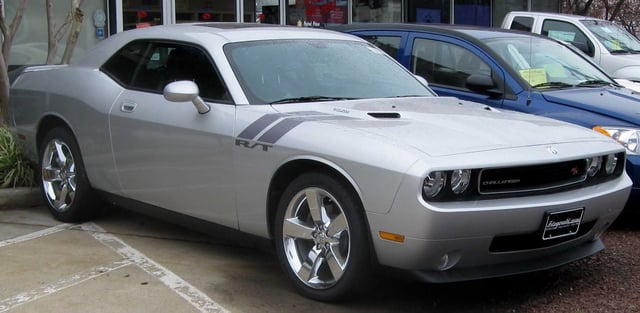
2009 Dodge Challenger R/T
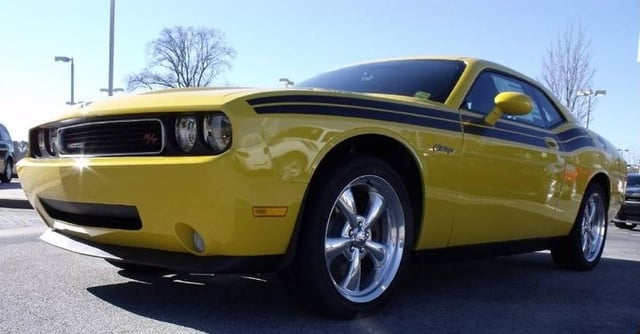
2010 Dodge Detonator Challenger R/T Classic
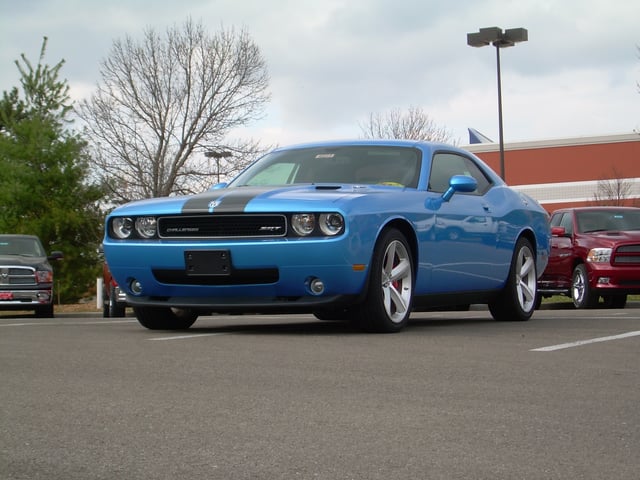
2010 Dodge Challenger SRT-8
Production of the limited edition 2008 SRT8s ended in July 2008, and production of the expanded 2009 line-up started in early August of the same year. The expanded offering was the same as had been unveiled earlier that spring at the 2008 New York Auto Show. Chrysler debuted the full Dodge Challenger line for 2009, with four different trims – SE, R/T, SRT8, and the SXT in Canada only. In addition to the SRT8, which remained unchanged except for the optional 6 speed manual and standard limited slip differential, the line-up included the previously mentioned SE and SXT which offered the 250 hp (186 kW) 3.5-Liter V6. The R/T hosted a 5.7 Hemi sporting 372 hp (277 kW) and 398 lb⋅ft (540 N⋅m) of torque when coupled with the 5 speed automatic, and 375 hp (280 kW) with 404 lb⋅ft (548 N⋅m) when matched with the same Tremec 6-speed manual transmission as the SRT8.
New for 2009 was the Rallye Package for the SE model. The package featured design cues including dual body stripes on the hood and the trunk, chromed fuel door, deck lid spoiler, 18-inch aluminum wheels, and Micro Carbon in the interior accents.
The mid-level Challenger R/T is powered by a 5.7 L (345 cu in) Hemi V8 coupled to a 5-speed automatic transmission or a Tremec TR-6060 6-speed manual transmission. On cars equipped with the automatic transmission, the engine features the Multi-Displacement System and produces 372 hp (277 kW) (SAE) and 398 lbf⋅ft (540 N⋅m) torque.[31] With the 6-speed manual transmission, the Multi-Displacement System option was deleted and the engine produced 375 hp (280 kW) (SAE) and 404 lbf⋅ft (548 N⋅m) torque.[31] Another feature was the Intelligent Deceleration Fuel Shut-Off (iDFSO) available for the automatic models only. The first to combine both a Multi-Displacement system and fuel shut-off.[33] The final drive ratio was 3.06:1 on cars with the automatic transmission, 3.73:1 on cars with the 6-speed manual and 18-inch (460 mm) wheels or 3.92:1 with the 6-speed manual and optional 20-inch (510 mm) wheels. Also available on R/T was the "Track Pak" option group, which includes the Tremec manual transmission, a limited slip differential and self-leveling rear shock absorbers.
The Challenger R/T Classic has retro aspects such as script "Challenger" badges on the front panels and black or white "R/T" stripes. It comes with a five-speed automatic standard, with an optional six-speed manual transmission including a pistol-grip-shifter. The wheels are Heritage 20" Torq-Thrust style specials. It became available in Brilliant Black Crystal Pearl, Bright Silver Metallic, Stone White and in multiple "heritage" colors: Toxic Orange, HEMI-Orange, TorRed, B5 Blue, Plum Crazy Purple, Detonator Yellow and Furious Fuchsia. Production started in February 2009.
The 2009 SRT8, while still equipped with the 6.1 L (370 cu in) Hemi V8, is virtually identical to its 2008 counterpart, with the main difference being the choice of either a 5-speed automatic or a 6-speed manual transmission. Standard features include Brembo brakes, a sport suspension, bi-xenon headlamps, heated leather sport seats, keyless go, Sirius satellite radio, and 20-inch (510 mm) forged aluminum wheels in addition to most amenities offered on the R/T and SE models such as air conditioning and cruise control.[32] In addition, the 2009 had a "limited slip" differential that was not offered on the 2008 model.[34] A "Spring Special" SRT8 Challenger was also offered in B5 Blue, but due to rolling plant shutdowns, just over 250 Spring Special Challengers were built before the end of the 2009 model year.
The "Mopar '10 Challenger R/T" is a limited version of the 2010 Challenger R/T with metallic pearl black body color, three accent colors (blue, red, silver) of stripes to choose from. In addition, these cars were available with black R/T Classic-style wheels along with a Hurst aftermarket pistol grip shifter, custom badging, Mopar cold air intake for a ten-horsepower increase, and a Katzkin-sourced aftermarket interior. The cars were built in Brampton Assembly and completed at the Mopar Upfit Center in Windsor, Ontario. There were 500 U.S. Units and 100 Canadian units built. Of the 500 Mopar special edition U.S. versions, 320 had automatic transmissions, 180 had manuals, while 255 had blue stripes, 115 had red stripes, and 130 had silver stripes. A limited numbered run of 400 SRTs in 2010 were produced with "Furious Fuchsia" paint and white leather seats with horizontal fuchsia colored slash bars on the back rests. Special badging on the passenger side dash script denotes the production number of each individual car ranging from the numbers 1 to 400. Dodge marketed this package as homage to the original Panther Pink cars 40 years previous.These cars came with both automatic and Tremac six speed transmissions.
The Drag Race Package is a race model designed for NHRA competition, based on the Dodge Challenger SRT-8. The car is 1,000 lb (454 kg) lighter than the street vehicle by eliminating major production components and systems. To accentuate the weight savings, they also feature added composite, polycarbonate and lightweight components designed for drag racing that will be part of the new Package Car program. The engine was repositioned to improve driveline angle and weight distribution. The 116-inch (2,900 mm) wheelbase was shortened by ½ inch. They also feature a front cradle with bolt-in crossmember and solid engine mounts.
At least 50 Challenger Drag Race Package Cars are being built to meet NHRA requirements. Engine options include a 6.1L HEMI, 5.7-L HEMI, and a 5.9L Magnum Wedge. Manual or automatic transmissions are available, and the rear axle is solid (not IRS). The initial run of the required 50 cars has been completed and over 100 of the "2009 Challenger Drag Pak" vehicles will be produced. Currently a 2010 program is being considered. "Big Daddy" Don Garlits bought the first drag race package car and has raced it in NHRA competition.[35] The prototype cars shown at SEMA were built by MPR Racing of Michigan, who continue to modify the production cars as delivered from Chrysler. Currently, the "Drag-Pak" cars running in legal A/SA trim are running around the 9.7–10 second mark at 130–140 mph in the quarter mile.
2010 model year
In its second year of production, the Challenger received only a few minor feature and option changes. Electronic stability control is newly standard across the entire Challenger model line. R/T models gained the following standard features: automatic headlamps, an LED-lit cupholder and door-handle lights. UConnect Multimedia and UConnect Navigation options now include steering-wheel audio controls while UConnect Multimedia features have been combined with the optional Sound Group.
The most significant new option for 2010 is the Super Track Pack, which brings a host of track-ready hardware and upgrades that includes:
20x9 wheels with Goodyear F1 Super Car tires
Front and rear Sachs Nivomat self-leveling shock-absorbers
Larger rear stabilizer bar (20mm > 16mm stock)
Variable displacement performance steering pump (standard on 6 speed)
3.06 rear-axle ratio (n/a on 6-speed R/Ts which maintain 3.92 ratio)
Anti-lock 4-Wheel disc heavy duty brakes with performance brake linings
"ESP-off" stability calibration. A limited slip differential remained standard only on R/Ts equipped with the 6 speed manual transmission.[36]
2011 model year
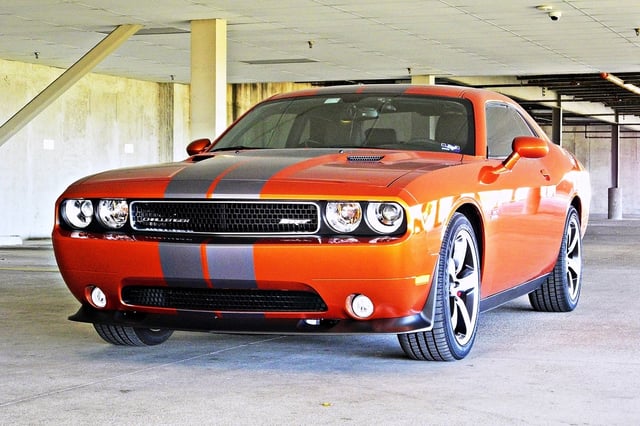
2011 Dodge Challenger SRT8
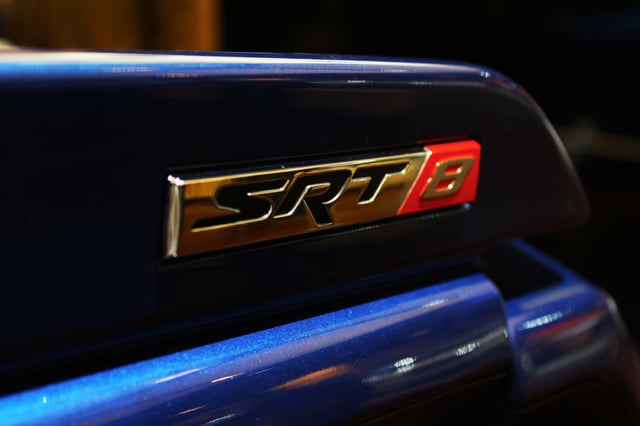
2011 Dodge Challenger SRT8 badge on rear spoiler
The Ram emblem disappeared with the 2011 model year (as the namesake truck was being spun off as its own brand), and Challengers received two new engines, the Pentastar, and a 392 Hemi.
The SE and SE Rallye received the new 3.6-liter Pentastar V6 engine producing 305 hp (227 kW; 309 PS) and 268 lb⋅ft (363 N⋅m), dual rear exhaust with bright tips, a five-speed automatic transmission with AutoStick, 18-inch aluminum wheels, advanced brake systems including: four-wheel disc antilock brakes, brake assist, ready alert braking and rain brake support, electronic stability control (ESC), with hill start assist and all-speed traction control, a chrome fuel filler door, Uconnect 130 System with AM/FM radio, CD player, six speakers and auxiliary input jack, steering wheel-mounted audio and speed control, twin hood scoops, touring suspension, remote keyless entry, six airbags, active front head restraints, premium cloth seating, six-way power driver seat with four-way power lumbar adjust, a leather-wrapped steering wheel, air conditioning with automatic temperature control, keyless enter and go with proximity sensor and push button start, power windows, locks & mirrors, a tilt/telescoping steering column and 60/40 folding rear seats that include a rear armrest with cup holders.
In 2011, the Challenger Rallye Package added dual red out-lined center stripes, premium leather interior with heated front seats, body-color rear spoiler, performance-tuned steering with sport suspension and handling package, further upgraded brakes, and unique Foose designed 18" Rallye wheels.[37]
The R/T received revisions including a new bottom grille cutout and an updated suspension.
The new SRT8's chin spoiler was enlarged to create more downforce. It resembles the 1970 Challenger R/T. The SRT8 received a new 6.4-liter Hemi V8.[38] The so-called 392 (although its actual size is 391 cu-in.) was officially rated at 470 hp (350 kW; 477 PS) and 470 lb⋅ft (637 N⋅m) of torque. Dodge engineers said they sacrificed peak horsepower ratings for low-end torque, stating a 90 lb⋅ft (122 N⋅m) increase over the outgoing 6.1-L (370 c.i.d.) Hemi V8 at 2900 rpm.[39] Two transmissions were offered: a 5-Speed Shiftable Automatic and a 6-speed manual. With the revised 6.4-Liter engine, Chrysler engineers cited a quarter mile (~400 m) time of 12.4 seconds at 110 mph (177 km/h) – bettering the outgoing 6.1-Liter Hemi by 0.8 seconds, although that figure has varied wildly between automotive magazines. Car and Driver tested the 392 at 12.9 seconds at 114 mph (183 km/h)[40] while Motor Trend ran it at 13.0 seconds at 111.3 mph (179.1 km/h)[41] and Edmunds' number was far closer to Chrysler's claimed numbers at 12.6 seconds at 112.1 mph (180.4 km/h).[42]
Top speeds of the 2011 Dodge Challenger R/T and 2011 Dodge Challenger SRT8 were both rated at 170 mph (274 km/h). The R/T has a 0 to 60 mph (0 to 97 km/h) acceleration of 5.00 seconds, while the SRT8 accelerates to 60 mph (97 km/h) in 4.50 seconds.
2012 model year
The base SE trim was renamed to SXT for consistency with the naming scheme of the remaining Dodge lineup. The SRT8 392 model gains a two-mode adaptive suspension system which features an Auto and Sport mode. The car uses a variety of sensors to measure inputs like vehicle speed, steering angle, brake torque, throttle position and acceleration forces to instantly tune the suspension for the given condition depending on what mode is chosen.[43] In addition, a new heated steering wheel featuring Chrysler's new paddle shifter system, new sport seats, and a 900 watt Harman Kardon audio system became available.[44]
2013 model year
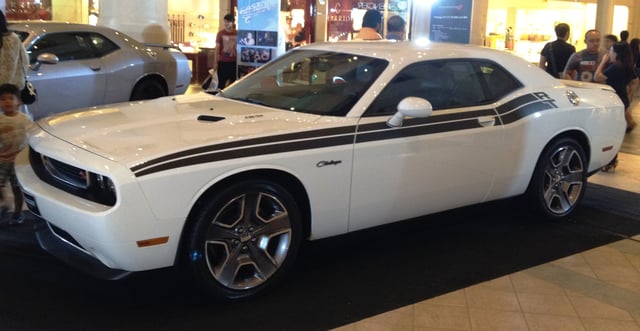
2013 Dodge Challenger R/T.
For 2013, a Rallye Redline package is available with Dodge Challenger V6 models. Based on the SXT Plus trim, the Rallye Redline package includes unique exterior accents, Black chrome 20-inch wheels with Redline Red accents, performance suspension and brakes, a 3.06 rear-axle ratio and available Radar Red Nappa leather interior.
The Electronic Vehicle Tracking System (EVTS), a GPS-enabled stolen vehicle recovery system, is available.
2014 model year
The Challenger largely soldiered on with minimal changes for 2014. A new performance package called the "Super Sport Group" was made available for V6 challengers and included the performance-suspension, steering, and brakes from the R/T challengers, a 3.07:1 axle ratio with 215mm rear axle for faster acceleration, rear spoiler, and 20-inch chrome wheels with wider P245/45R20 all-season performance tires. The "Sinister Super Sport pack" was a Super Sport Group but with black wheels instead of chrome. The Challenger SRT8 also gained a launch control system.[45]
Dodge Challenger 100th Anniversary Edition
The 100th Anniversary Edition is a version of 2014 Dodge Challenger SXT Plus with Pentastar V-6 engine or R/T Plus with HEMI V-8 engine, commemorating the 100th anniversary of brothers Horace Elgin Dodge and John Francis Dodge introducing the Dodge Model 30, with choice of 8 body colors (Pitch Black, Bright White, Billet Silver, Granite Crystal, Ivory Tri-Coat, Phantom Black Tri-Coat, Header Orange and an exclusive High Octane Red pearl), 20x8-inch polished five-spoke aluminum wheels with Granite Crystal pockets, "Dodge Est. 1914" bar-style front-fender badges, Dodge "100" logo on the center caps, a body-color rear spoiler, a red "R/T" heritage grille badge on R/T Plus model, sport seats with all-new Molten Red or Foundry Black Nappa leather upholstery, a custom cloud overprint at sport seats, center console armrest and door armrests; a unique three-spoke flat-bottom performance steering wheel with die-cast paddle shifters, brass-colored accent stitching on leather-wrapped surfaces, Dark Brushed Graphite center console bezels, Liquid Graphite steering-wheel accents, die-cast "Dodge Est. 1914" circular badges on front seatbacks, an embroidered anniversary logo on floor mats, all-new instrument panel cluster graphics (unique black-face gauges with white indication, stand-out red "100" mph indication), Electronic Vehicle Information Center and Uconnect touchscreen Radio with unique startup image, sport mode calibration, performance-tuned suspension, two unique key fobs with 100th Anniversary Edition jeweled logo on the back side, a customized owner's kit, a special commemorative book celebrating the 100 years of Dodge heritage.
2015 model year (facelift)
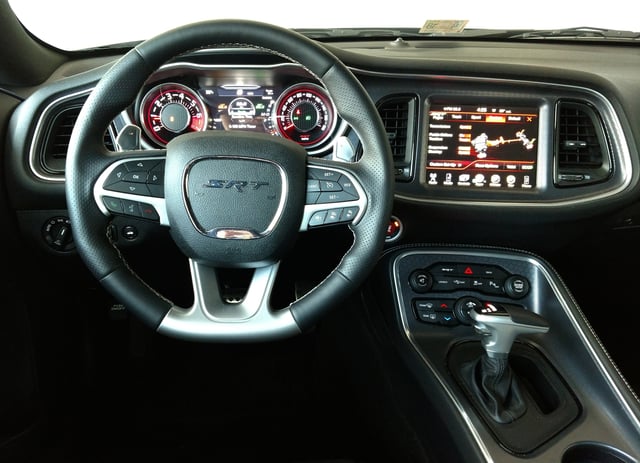
Redesigned interior of the 2015 Challenger (SRT 392 depicted)
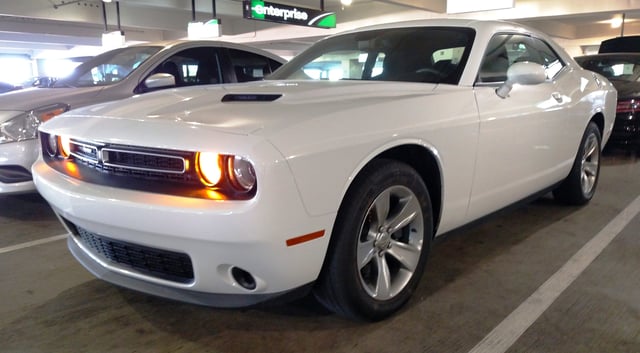
2015 Challenger SXT (note the grille's dual snorkels from the 1971 Challenger)
For the 2015 year, changes include:[50]
The high-performance "SRT-8" trim has been retired, replaced by SRT 392 and SRT Hellcat.
5-speed automatic transmission replaced by a new 8-speed ZF 8HP automatic transmission
Power output on the 6.4 liter Apache V8 increased by 15 horsepower and 5 lb-ft for a total of 485 horsepower and 475 lb-ft
A slightly revamped exterior features a new grille with design cues from the 1971 grill/split tail lights, Quad LED 'Halo Ring" Head lights, LED Tail lights, and a functional hood intake on HEMI models.
Inside, the Challenger gets a 7-inch (780mm) TFT Thin Film Transistor display with over one hundred possible configurations, 8.4-inch Uconnect touchscreen radio with available navigation, and a retro styled gauge cluster.
Six-Piston front Brembo brakes with Two-Piece 15.4-Inch Vented/Slotted Rotors and 4-Piston rear Brembo brakes on SRT 392 and SRT Hellcat models.
SRT Hellcat
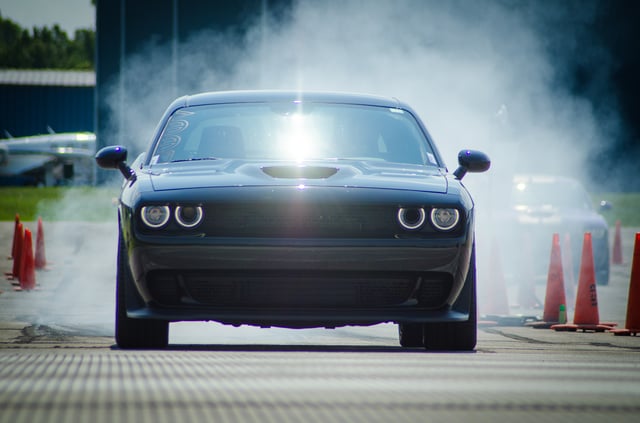
Dodge Challenger Hellcat rolling down the dragstrip
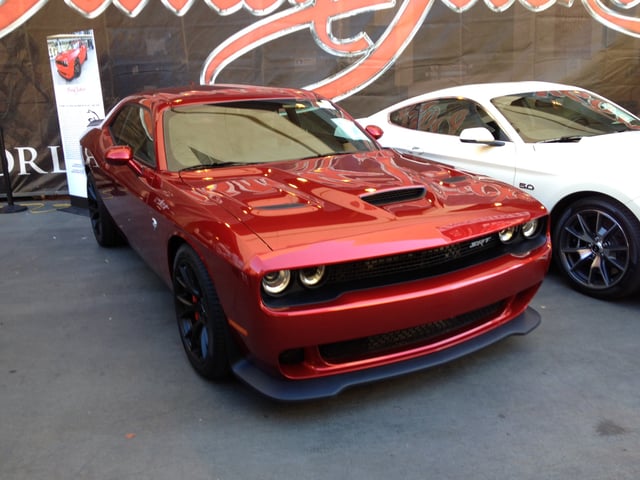
2015 Challenger SRT Hellcat in custom Stryker Red (VIN# 0001)
This version of the 2015 Dodge Challenger with a supercharged 6.2-liter HEMI engine is rated at 707 hp (527 kW) and 650 lb⋅ft (881 N⋅m) of torque. This engine is also available in the Dodge Charger SRT Hellcat full-sized sedan, the Jeep Grand Cherokee Trackhawk SUV, and the Hellcrate engine swap kit. The inner driving light on the left front has been removed to allow air to get into the engine resulting in more torque, and the wheel wells are different from the standard SRT to accommodate the 20-inch aluminum wheels. The SRT Hellcat is equipped with two separate key fobs; use of the "black" fob limits engine output to 500 hp (373 kW), while the "red" fob enables full output capability.[51] The Hellcat has a quarter mile time of 10.85 seconds; this was accomplished with street legal drag tires. On stock tires the Hellcat was able to achieve 11.2 seconds at 125 mph (201 km/h) on the quarter mile.[52]
The Challenger SRT Hellcat can accelerate from 0–60 mph (97 km/h) in 3.6 seconds and can brake from 60–0 in 109 ft (33 m). Top speed is 199 mph (320 km/h). The Challenger Hellcat has a lateral acceleration of 0.94 g.
The Challenger Hellcat has a power to weight ratio of 2.81 kg (6.19 lb) per horsepower.
2016 model year

2016 Hellcat (Texas Dealer special edition)

2016 Hellcat (Texas Dealer special edition)
In 2016, there were no major changes introduced. Some Texas Dodge Dealers sold a limited edition version of the Hellcat, which were lowered about 2.5 cm in the back, 3 cm in the front, came with an upgraded supercharger which was dynamometer tested at between 745 and 750 hp (556 and 559 kW) (readouts were packaged with the autos), featured 305/35 20 rear-wheel tires, and all vehicles were backed by a standard factory warranty. Most were white with black Carbon-fiber 'rally stripes', but a small number were red, with black carbon-fiber stripes. The upgraded models were 'sticker priced' at about $80,000. The program was terminated by Dodge, who announced the 2017 Challenger Hellcat with upgraded performance, and began work on The Demon model (which was not available for sale until the 2018 model year).
2017 model year

2017 Challenger GT in Graphite Crystal. Note the higher stance of the Pursuit-based suspension.
For the 2017 model year, a GT model was introduced with an all-wheel drive (AWD) version of the SXT Plus.[59] The Challenger GT uses the same AWD system and suspension as the Dodge Charger Pursuit. It is available exclusively with the 3.6-Liter V6 Pentastar engine and the 8-speed automatic transmission.
The AWD system includes both an active transfer case and front-axle disconnect system. The system defaults to rear-wheel drive (RWD) but can seamlessly transition between RWD and AWD if certain conditions are met, like low external temperature, rainfall, or loss of traction. No driver input is required.[60] In Sport Mode, the car uses AWD exclusively. The AWD system in the Challenger GT is configured to be rear-biased (applies more power to the rear wheels). Only up to 38% of power is transferred to the front wheels.
Other model additions include the 5.7-liter V8 equipped T/A and 6.4-liter V8 equipped T/A 392 models. T/A models include a black painted hood with center air intake, black roof, black decklid, bodyside graphics, a cold-air induction system through the front head lamps similar to that used in the Challenger SRT Hellcat, Houndstooth cloth performance seats, and white-faced gauges. T/A 392 models include everything on T/A models in addition to the more powerful 6.4 L V8, six-piston front Brembo brakes with two-piece 15.4-inch vented/slotted rotors and 4-piston rear Brembo brakes, and 20x9.5-inch wheels with 275/40ZR20 tires. Every Challenger gains an updated Uconnect infotainment system; the optional 8.4-inch touchscreen with navigation adds multitouch gestures.
Models equipped with the 5.7-liter V-8 now have an electronically controlled low-restriction active exhaust for a more aggressive exhaust note. Among the other additions are standard Houndstooth cloth seats on some models and revised paint choices. Green Go, Yellow Jacket, Destroyer Grey, and Octane Red are new colors, while White Knuckle and Contusion Blue are renamed carryovers.[61]
2018 model year
Minor changes were made for the 2018 model year. For SXT and R/T models equipped with the 3.6-liter V6 and 5.7-liter V8, an all new Performance Handling Group package is available. This package adds 4-piston black Brembo brakes (a $500 option for red brake calipers is optional) in the front along with a Bilstein performance suspension, 20x9 inch wheels with 245/45ZR20 performance tires, and upgraded steering. The Challenger GT gains a new 19-inch wheel option while SXT Plus and R/T Plus trims equipped with the Super Trak package come with nappa leather and microsuede sport seats. The SXT, R/T, R/T Shaker, and T/A models receive a standard 7.0-inch Uconnect touchscreen. A backup camera is now standard. For exterior colors, new additions include F8 Green, IndiGO Blue, B5 Blue and Plum Crazy.[61]
SRT Demon
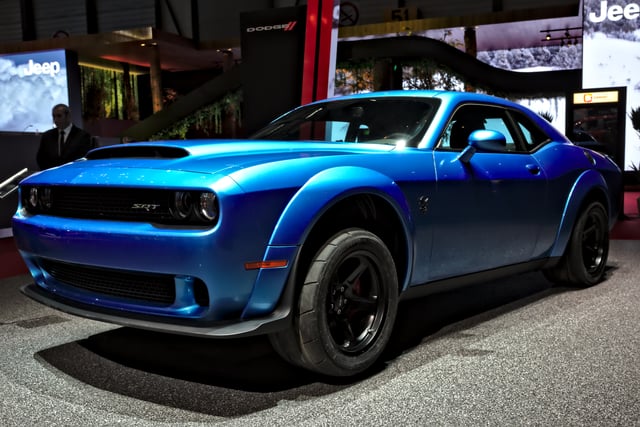
Dodge Challenger Demon at the 2018 Geneva Motor Show
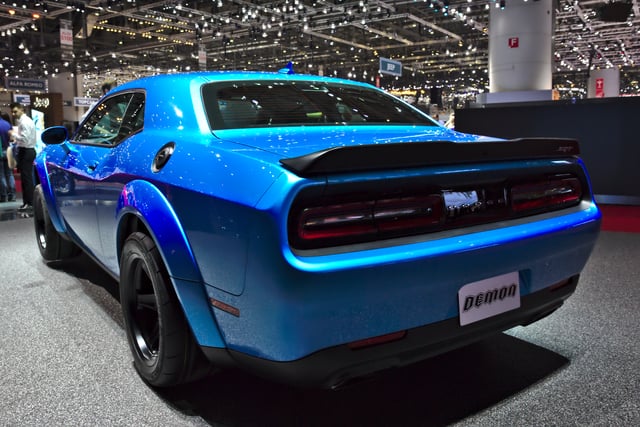
Rear view.
The SRT Demon is a more powerful wide body version of the Challenger. It debuted during the New York Auto Show in April 2017.[62]
The Demon uses an all-new 6.2-liter V8 engine equipped with a 2.7-liter supercharger, which puts out 808 hp (603 kW; 819 PS) with 91 octane gasoline and 840 hp (626 kW; 852 PS) with 100 octane fuel or higher (both outputs are with the red key). Torque stands at 770 lb⋅ft (1,044 N⋅m) on 100 octane fuel. The car weighs 98 kg (215 lb) less than the Hellcat, the total being 1,930 kg (4,254 lb). The car will be using a set of road tires by Nitto Tire, called the NT05R. The tires are the 315/40R18 variations at both front and rear. The tires are targeted for the drag strip, but have enough footprint to make it legal for the road. This tire, although an NT05R consumer tire, is a variation built specifically to withstand the power output of the Demon. This makes the Challenger SRT Demon the first production car to contain a set of drag radial road tires.[63] The SRT Demon contains a system that is used specifically for drag racing called transbrake, which is a mechanism that puts the transmission in 1st gear and the reverse gear simultaneously, holding the Demon stationary.[64] This is used along with the car's torque converter to build up hydraulic pressure before launch.
The power-to-weight ratio of the SRT Demon is 418 hp (312 kW; 424 PS) per ton on 91 octane gasoline and 435 hp (324 kW; 441 PS) per ton on 100 octane or higher.
It reaches 0–30 mph (0–48 km/h) in 1.0 second, 0–60 mph (0–97 km/h) in 2.3 seconds (2.0s with a rollout), 0–100 mph (0–161 km/h) in 5.1 seconds, a top speed of 168 mph (270 km/h) (factory limited), and the quarter mile (400 m) in only 9.65 seconds at 140.09 mph (225.45 km/h).[65] This makes the Demon the fastest non-electric production car to reach 0-60 mph (0–97 km/h) and to complete a straight-line quarter mile at its time of announcement. The SRT Demon is also capable of accelerating at 1.8 G's of force at launch, making this the hardest launching production car ever.[66] The Demon can also push the boost to 14.5 psi and redline up to 6500 rpm. With this extreme power, and hard accelerating, the SRT Demon is the first production car to ever perform a wheelie.[67] With the control module from the "Demon Crate" and high-speed tires, the Demon has reached over 200 mph (320 km/h) in test runs. [68]
Because of the lack of an NHRA certified roll cage, which is required if the quarter mile time is under 10 seconds, the NHRA banned the vehicle from competition.[69]
Like the SRT Hellcat, it comes with both red and black key fobs, with the black fob limiting the power output to 500 hp (373 kW). With the red key and the use of 100+ octane gasoline, the Demon can reach its full power potential. Only 3,300 SRT Demons will be produced, with production beginning in the summer of 2017 and release in the fall of 2017, and is expected to be priced at less than US$100,000.[70][71]
The interior of the SRT Demon is the same as all other Challenger trims, but with changes that differentiate it to the other trims. The Demon only includes a front driver's seat as standard, and no other seats front or rear in the vehicle. However, the front passenger's seat, as well as a rear bench seat, can both be added back as options for one dollar each. To replace the rear seats, Dodge included rear roll bars, and has a 4-point harness installed on it for the driver seat.[72] The dashboard display and the seats now have the Demon logo on them,[73][74] and includes a performance display on it, as well as on the center console touch screen.[75]
Removed front passenger seat and passenger seatbelt (−58 lb (−26 kg) decrease; seats available at a dollar)[64]
Removed rear bench seat, seatbelts, restraints, and front and rear floor mats (−55 lb (−25 kg) decrease)
Removed 16 Harman Kardon audio speakers, factory subwoofer, amplifier, and all electrical wiring (−24 lb (−11 kg) decrease)
Removed rear trunk deck lid cover trim, trunk carpeting, and spare tire cover (−20 lb (−9 kg) decrease)
Used smaller, hollower front and rear sway bars (−19 lb (−9 kg) decrease)
Removed mastic, body deadeners, insulators, and foam (−18 lb (−8 kg) decrease)
Used lightweight, all-aluminum four-piston front and rear brake calipers and 360 mm (14 in) front and rear two-piece brake rotors (−16 lb (−7 kg) decrease)
Installed lightweight aluminum front and rear alloy wheels and open-ended front and rear wheel lug nuts (−16 lb (−7 kg) decrease)
Replaced power-tilting and telescoping steering column with manually-tilting and telescoping steering column (−4 lb (−2 kg) decrease)
Removed front and rear ParkSense parking sensors and ParkSense front and rear park sensor module (−2 lb (−1 kg) decrease)
Specifications
Specifications of the Challenger SRT Demon are as follows:[76]
6.2-liter supercharged HEMI V8 engine, includes 2.7-liter supercharger (840 hp (626 kW; 852 PS) and 770 lb⋅ft (1,044 N⋅m) using 100 octane racing fuel or higher, or 808 hp (603 kW; 819 PS) and 717 lb⋅ft (972 N⋅m) using 91 octane premium fuel
8-speed ZF 8HP semi-automatic transmission as standard, with steering wheel mounted shift paddles
Runs on 91 octane premium fuel or 100 octane racing fuel, has a fuel mode that enables the 100 octane (first ever in street-legal production car)
1.8 Gs of longitudinal G-force at launch
Total curb weight of 1,930 kg (4,255 lb) (98 kg (215 lb) less than SRT Hellcat)
Air conditioning
Uconnect 8.4 in (21 cm) touchscreen audio system (w/ SRT performance pages)
Front and rear fender flares (adds 3.5 in (9 cm) to overall width of car)
Alcantara-wrapped steering wheel (w/ shift paddles mounted on it)
Stitched or embossed Demon emblems on front seatbacks
200 mph (322 km/h) speedometer (w/ Demon-themed TFT reconfigurable instrument cluster)
Factory-installed transbrake System (first ever in street-legal production car)
18 in (46 cm) street-legal, Drag Radial Tires (first ever in street-legal production car)
Factory-installed SRT "Power Chiller" (system that uses the vehicle's air conditioning to pre-cool the intercooler before the run and thus further compress air from the supercharger)
"Drag Mode" suspension system (first ever in street-legal production car)
Front passenger and rear bench seat delete with rear roll bar (items can be re-added for a dollar each)[64]
"Torque Reserve on Demand" system (first ever in street-legal production car)
Functional hood scoop (largest hood scoop in any production car)
2-Speaker Audio System (Harman Kardon audio system is optional)
The "Demon Crate"
Each Demon purchaser will also receive a Demon Crate with their order, which contains the following items:[76]
Direct-connection powertrain control module (PCM)
Low-restriction air filter
High-octane racing fuel switch bank
Personalized and serialized carbon fiber instrument panel badge
Passenger-side exterior door mirror delete plate
Lightweight hydraulic floor jack (w/ Demon logo)
Torque wrench with associated sockets (w/ Demon logo)
Tire pressure gauge (w/ Demon Logo)
Impact wrench; cordless and rechargeable (w/ Demon logo and charger)
Fender cover (w/ Demon logo)
Tool bag (w/ Demon logo)
"Demon Track Pack System"[78]
Personalized and serialized badge (w/ Demon logo)
Discontinuation
The last SRT Demon rolled off the assembly line in Brampton, Ontario, Canada on May 31, 2018. It was sold at a Barrett-Jackson auction in June 2018 alongside the final Dodge Viper.
2019 model year
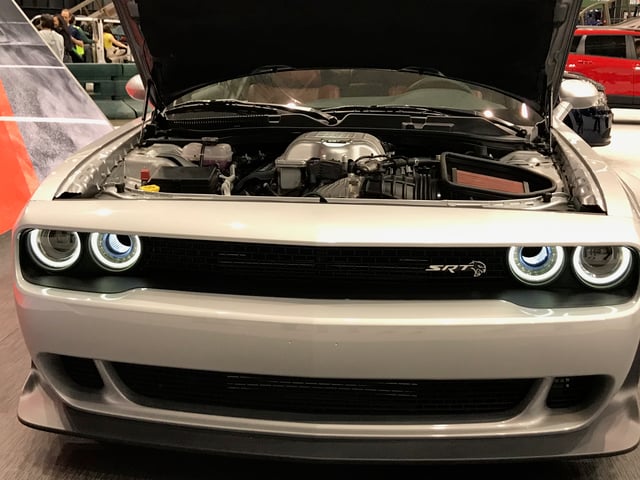
2019 Challenger Hellcat Redeye's supercharged 6.2L V8 HEMI, at the Cleveland Auto Show
For the 2019 model year, Dodge released new high performance versions of the challenger, trimmed the line-up down to six models, and made numerous other tweaks and changes. The model line-up for 2019 includes the following trims: SXT, GT, R/T, R/T Scat Pack, SRT Hellcat, and SRT Hellcat Redeye. Both SXT and GT models are now available in both rear and all wheel drive, with the GT previously having been the only model available in AWD. GTs gain a more aggressive look with a performance hood, front splitter, and steering and suspension while maintaining the optional performance handling group which includes wider wheels, performance summer tires, 4-piston Brembo brakes, and fixed-rate Bilstein suspension. The SXT model loses the performance handling group as an option, lacks the more aggressive exterior upgrades of the GT and has less aggressive gearing, making it the cheaper economical alternative. R/T Scat Pack models come with a new power-bulge aluminum hood standard. Plucked from the SRT Hellcat, this hood features dual air extractors that cool the engine and help reduce lift. For 5.7L and 6.4L V8 R/T models, the rear seats can be deleted at the cost of $1 and have a net weight savings of 55 lbs. In addition, a second level of the performance handling group called the "performance plus package" is offered, providing 20-Inch x 9.5-inch low-gloss black forged wheels, 275/40ZR20 Pirelli P Zero summer tires, and a limited slip differential in addition to the upgrades found in the performance handling group which remains unchanged since its introduction in 2018.[79]
SRT Hellcat: A slight increase in power is present for 2019, with horsepower rising to 717 and lb-ft to 656. A new dual snorkel hood is also new. Additionally, the ’19 model’s starting price is more than $5,500 lower compared to the 2018 model. A 6-speed Tremec manual and ZF 8-speed automatic remain the sole transmission options.
SRT Hellcat Redeye: Following the discontinuation of the Demon, the Redeye was created to fill the void. Essentially a heavily upgraded Hellcat, the Redeye is equipped with a slightly less powerful (due to a smaller hood intake system) Demon engine: a supercharged 6.2L V8 producing 797 horsepower and 707 lb-ft of torque, an increase of 90 hp (67 kW) and 11 lb⋅ft (15 N⋅m) over the standard Hellcat motor. Other upgrades include reinforced ZF 8 speed automatic, track-tuned suspension, Torque Reserve and 41-Spline Heavy-Duty Half-Shafts, and SRT Power Chiller® and After-Run Chiller.
Scat Pack 1320 Package: Equipped with the venerable 6.4L Chrysler Hemi Engine producing 485 hp (362 kW) and 475 lb⋅ft (644 N⋅m), the Scat Pack 1320 adds 20-Inch x 9.5-Inch Low Gloss Black Drag Wheels, 275/40R20 102W drag radial tires, adaptive damping suspension, SRT-tuned drag suspension, air catcher headlamps, deletion of front and rear passenger seats, a special speed limited engine controller, extreme-duty 41-spline half shafts and a trans-brake. Specially developed Nexen 275/40R20l street-legal drag radial tires are available for better grip.
The Dodge Challenger R/T Scat Pack 1320 can be modified for NHRA competition in accordance with Stock and Super Stock class rules. It will feature a class weight break of 8.72 and carry a minimum weight of 3,400 pounds. Contestants intending to compete at an NHRA event must meet all regulations for the category entered.[80]
Widebody Package: For 2019, buyers will be able to order their Challenger Scat Pack, SRT Hellcat, and SRT Hellcat Redeye with the "Widebody Package".[81] When purchased, the challenger gains the following:
Widebody fender flares
20x11 Devils Rim forged aluminum wheels
305/35ZR20 Pirelli 3-season performance tires
3-mode Bilstein adaptive damping suspension uniquely tuned for competition use
6-piston calipers with 15.4 inch vented and slotted rotors in the front (standard on Hellcat and hellcat Redeye models)
Stiffened anti-roll bars sized 34mm in front and 22mm rear (standard on Hellcat and hellcat Redeye models)
Limited production 3rd party variants

IIHS roof strength test on a 2016 Dodge Challenger R/T
In addition to official Dodge concept cars, there have been numerous limited production and street legal variants created by third parties, based on stock cars that have been rebuilt with modified powertrains, suspensions, and interiors. These include the SMS 570 and (supercharged) 570X with up to a claimed 700 bhp (522 kW), the Mr. Norm's Challengers with a claimed 637 or 900 bhp (475 or 671 kW) horsepower, the supercharged SpeedFactory SF600R with around 600 bhp (447 kW), the supercharged Richard Petty Signature Series with a claimed 610 bhp (455 kW), and the Legacy by Petty Convertible Challenger completely customized by Petty's Garage to include a one of a kind front end and NASCAR styled treatments.[82][83] Every year a handful (12 or less) Challenger convertibles are created by various conversion companies. The cars cost close to $100,000.
| Small overlap–driver | Marginal | |
| Moderate overlap | Good | |
| Side | Good | |
| Roof strength | Acceptable | |
| Head restraints and seats | Acceptable | |
| Front crash prevention (automated avoidance) | Basic | |
| LATCH (ease of use) | Acceptable | |
| Model Year | USA | Canada | México |
|---|---|---|---|
| 2008[85] | 7,209: SRT-8 Total: 17,423 | 1,631 | 284[86] |
| 2009[87] | 9,834: SRT8 Total: 25,852 | 2,660 | 305 |
| 2010[87] | 10,156: SRT8 Total: 36,791 | 3,097 | 179 |
| 2011[87] | 5,265: SRT8 Total: 39,534 | 2,350 | 197 |
| 2012[87] | 7,210: SRT8 Total: 46,788 | 1,485 | 295 |
| 2013[87] | Total: 51,462 | 1,514 | 491 |
| 2014[88] | Total: 51,611 | 1,623 | |
| 2015[89] | Total: 66,365 | 2,669 | |
| 2016[90] | Total: 64,433 | 3,158 | |
| 2017 | Total: 64,537 | 3,422 | 116 |
| 2018[91][92] | Total: 66,716 | 3,457 | 161[93] |
Total known sales = 560,606 | |||
Racing
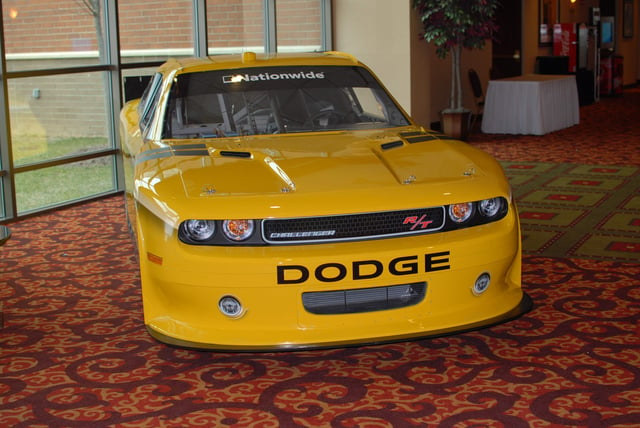
Early version of the Nationwide Series Challenger R/T
[[INLINE_IMAGE|//upload.wikimedia.org/wikipedia/commons/thumb/2/26/Challenger_Sebring.jpg/220px-Challenger_Sebring.jpg|//upload.wikimedia.org/wikipedia/commons/thumb/2/26/Challenger_Sebring.jpg/330px-Challenger_Sebring.jpg 1.5x, //upload.wikimedia.org/wikipedia/commons/thumb/2/26/Challenger_Sebring.jpg/440px-Challenger_Sebring.jpg 2x||h147|w220|thumbimage]] 2017 Trans Am TA class Challenger at SebringThe Challenger was introduced to the SCCA Trans Am Series in 1970. Two factory-backed cars were prepared by Ray Caldwell's Autodynamics and driven by Sam Posey and Tony Adamowicz. The No.77 car was built at Autodynamics from a street Challenger T/A that was taken from a local dealer showroom. The No.76 chassis arrived mid-season from Dan Gurney's All-American Racers, and was completed by Autodynamics.
Dodge's early to mid-1970s factory-supported "Kit Car" program for short-track late-model stock car racing offered a choice of Challenger, and a few (less than 12) were made, but in 1974 Dodge ended the Challenger line and they went to the Dodge Dart Sports and Dodge Aspen bodies over a steel-tube chassis.[94]
Blackforest Motorsports has currently entered a Challenger in the Continental Challenge.[95]
The Challenger R/T has been used as the Chrysler model for starting in 2010 NASCAR Nationwide Series competition.[96]
With Dodge officially out of NASCAR at the end of the 2012 season, the remaining cars and racing parts have been bought up by "privateer" racing teams and continue to show up in Nationwide Series during the 2013 and 2014 seasons. J. J. Yeley indicated his two-car team would continue to field a Challenger in the series for as long as he can find parts to keep the cars running. The team stopped after the 2014 season after his No. 93 (later No. 28) regularly ran in the top-20 during races, though the Mike Harmon-owned No. 74 and the Derek White-operated No. 40 qualified and ran Dodges in 2015. Mike Harmon Racing ran a Dodge the entire season and also did so in 2016, and has raced in over half of the 2017 season so far. Likewise, White's MBM Motorsports team fielded the Nos. 13 and 40 as Dodges in some races.[97] MBM continues to field Dodges into 2018 with Timmy Hill in the 66 (was the 13).
In late 2014 two Challengers fielded by Miller Racing with the support of SRT and Mopar driven by Cameron Lawrence and Joe Stevens started racing in the Trans-Am Series's TA2 class. Both cars used a spec Howe road racing tube chassis with fiberglass bodies. Powered by a Hemi 392 slightly modified for road racing extremes and restricted by class rules, the cars made around 500 horsepower. Except for slightly bulged fenders and large rear wing, the cars look very much like the stock/street version, despite being roughly 7/8s the size of the road car. Lawrence won four of 12 races in the 2015 season, finishing third overall in the Trans Am TA2 championship. Joe Stevens in the No. 11 "Green Car" finished sixth overall after a fourth place at the season finale at Daytona International Speedway. Joe Stevens also received the Cool Shirt Hard Charger award for his excellent rookie season performance. For the 2016 season, the Stevens-Miller Team fielded three Challengers in the TA2 series and ran in 16 events, scoring a few wins. The No. 77 car was painted in a throw-back paint scheme very similar to the 1970 No. 77 car driven by Sam Posey. The No. 12 car occasionally fielded a blue scheme paying tribute to the Plymouth Cuda Trans-Am car driven by Swede Savage.
In March 2017 the Challenger returned to the TA class in Trans-Am at Sebring after a nearly 40-year absence from Trans-Am's fastest class of racing. It was driven by Jeff Hinkle under the American V8 Road Racing team with John Debenedictis as crew chief. The car was orange and purple with stripes of many of the other challenger colors to celebrate the current stable of street cars. It is powered by a Penske Engines Mopar R5 / P7 carburated motor producing 855 hp (638 kW). In its debut it qualified 16th and finished 9th out of a field of 24.
At all Superbike World Championship races held in the United States, Fiat's Alfa Romeo safety car is replaced with Chrysler's Dodge Challenger.




